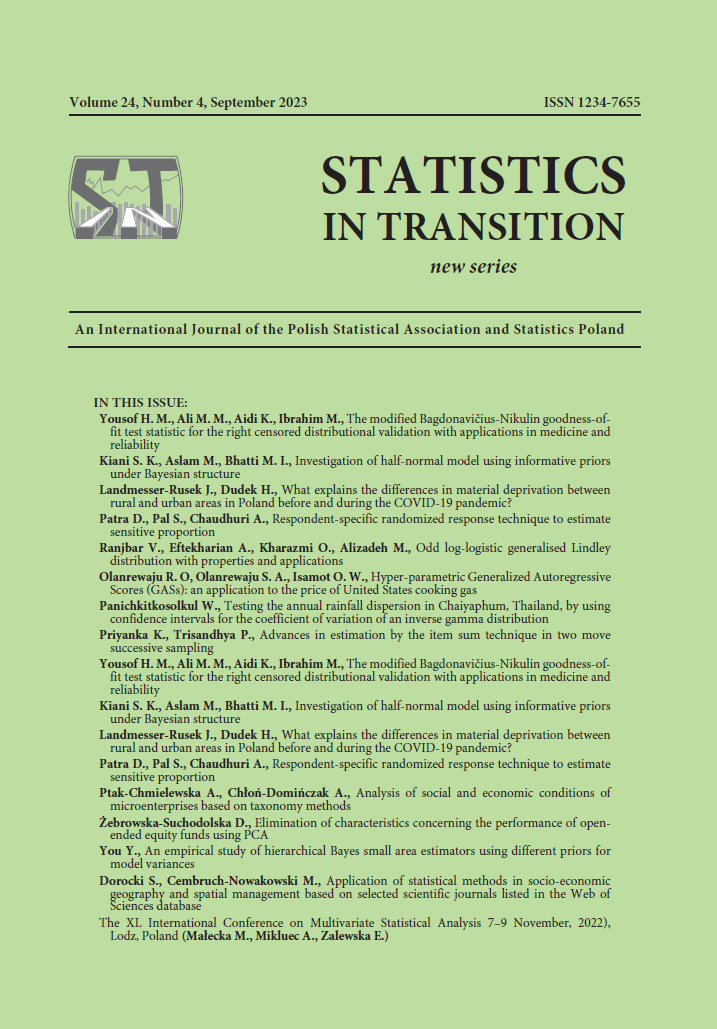ARTICLE
ABSTRACT
The present article proposes an estimator using the Item Sum Technique (IST) for the estimation of dynamic sensitive population mean using non-sensitive auxiliary information in the two-move successive sampling. Properties of the proposed IST estimator have been analysed. Possible allocation designs for allocating long-list and short-list samples pertaining to the IST have been elaborated. The comparison between various allocation designs has been carried out. Theoretical considerations have been integrated with numerical as well as simulation studies to show the working version of the proposed IST estimators in the two-move successive sampling.
KEYWORDS
Sensitive variable, Successive moves, Population mean, Variance, Mean squared error, Optimum matching fraction
REFERENCES
Arcos, A., Rueda, M. and Singh, S. A., (2015). Generalized approach to randomized response for quantitative variables. Quality and Quantity, 49, pp. 1239 –1256.
Arnab R., Singh S., (2013). Estimation of mean of sensitive characteristics for successive sampling. Communication in Statistics-Theory and Methods, 42, 2499–2524.
Chaudhuri,A., Christofides,T. C., (2013). Indirect questioning in sample surveys. Springer- Verlag, Berlin, Heidelberg, De.
Diana, G., Perri, P. F., (2010). New scrambled response models for estimating the mean of a sensitive quantitative character. Journal of Applied Statistics, 37(11), pp. 1875– 1890.
Diana, G., Perri, P. F., (2011). A class of estimators for quantitative sensitive data. Statistical Papers, 52(3), pp. 633–650.
Eichhorn, B. H., Hayre, L. S., (1983). Scrambled randomized response method for obtaining sensitive quantitative data. Journal of Statistical Planning and Inference, 7(4), pp. 307–316.
Franklin, L. A., (1989). A comparison of estimators for randomized response sampling with continuous distribution from dichotomous populations. Communications in Statistics- Theory and Methods, 18, pp. 489–505.
Garcia, A. V., Artes, E. M., (2002). Improvement on estimating of current population ratio in successive sampling. Brazilian Journal of Probability and Statistics, 16(2), pp. 107–122.
Greenberg, B. G., Kubler, R. R., Horvitz, D. G., (1971). Application of the randomized technique in obtaining quantitative data. Journal of the American Statistical Association, 66, pp. 243–250.
Holbrook, A. L., Krosnick, J. A., (2010). Social Desirability Bias in Voter Turnout Reports: Tests Using the Item Count Technique. Public Opinion Quarterly, 74, pp. 37–67.
Horvitz, D. G., Shah, B. V., Simmons, W. R., (1967). The unrelated question randomized response model. Journal of the American Statistical Association, pp. 65–72.
LaBrie, J. W., Earleywine, M., (2000). Sexual Risk Behaviors and Alcohol: Higher Base Rates Revealed Using the Unmatched-count Technique. Journal of Sex Research, 37, pp. 321–326.
Miller, J. D., (1984). A New Survey Technique For Studying Deviant Behavior.The George Washington University Ph.D. thesis.
Mukhopadhyay, P., (2014). Theory and Methods of Survey Sampling. PHI Learning Private Limited, Delhi.
Patterson, H. D., (1950). Sampling on successive occasions with partial replacement units. Journal of royal statistical society, Wiley, series B(Mthodoligical) 12(2), pp. 241–255.
Perri, P. F., Diana, G., (2013). Scrambled response models Based on auxiliary variables. In: Torelli, N., Pesarin, F., Bar-Hen, A. (eds.). Advances in Theoretical and Applied Statistics, Springer, Berlin, pp. 281–291.
Perri, P. F., Rueda, M. M. G., Cobo, B. R., (2018). Multiple sensitive estimation and optimal sample size allocation in the item sum technique. Biometrical Journal, 60, pp. 155–173.
Pollock, K. H., Bek, Y., (1976). A comparison of three randomized response models for quantitative data. Journal of American Statistical Association, 71, pp. 884–886.
Priyanka, K., Trisandhya, P. and Mittal, R., (2018). Dealing sensitive characters on successive occasions through a general class of estimators using scrambled response techniques. Metron, 76, pp. 203–230.
Priyanka, K., Trisandhya, P., (2019). A Composite Class of Estimators using Scrambled Response Mechanism for Sensitive Population mean in Successive Sampling. Communications in statistics- Theory and Methods, 48(4), pp. 1009–1032.
Priyanka, K., Trisandhya, P. and Mittal, R., (2019). Scrambled Response Techniques in Two Wave Rotation Sampling for Estimating Population Mean of Sensitive Characteristics with Case Study. Journal of Indian Society of Agricultural Statistics, 73(1), pp. 41–52.
Rayburn, N. R., M. Earleywine, and Davison, G. C., (2003). Base Rates of Hate Crime Victimization among College Students. Journal of Interpersonal Violence, 18, pp. 1209– 1221.
Srivastava, S. K., Jhajj H. S., (1980). A class of estimators using auxiliary information for estimating finite population variance. Sankya series C, 42, pp. 87–96.
Tracy, D. S., Singh, H. P. and Singh, R., (1996). An alternative to the ratio-cum-product estimator in sample surveys. Journal of Statistical Planning and Inference, 53, pp. 375– 397.
Trappmann, M., Krumpal, I., Kirchner, A., and Jann, B., (2014). Item sum: A new technique for asking quantitative sensitive questions. Journal of Survey Statistics and Methodology, 2, pp. 58–77.
Tsuchiya, T., Hirai, Y. and Ono, S., (2007). A Study of the Properties of the Item Count Technique. Public Opinion Quarterly, 71, pp. 253–272.
Warner, S. L., (1965). Randomized response: a survey technique for eliminating evasive answer bias. Journal of the American Statistical Association, 60, pp. 63–69.
Wimbush, J. C., Dalton, D. R., (1997). Base Rate for Employee Theft: Convergence of Multiple Methods. Journal of Applied Psychology, 82, pp. 756–763.
Yu, B., Jin, Z., Tian, J. and Gao, G., (2015). Estimation of sensitive proportion by randomized response data in successive sampling. Computational and Mathematical Methods in Medicine, pp 6, DOI: 10.1155/2015/172918.
